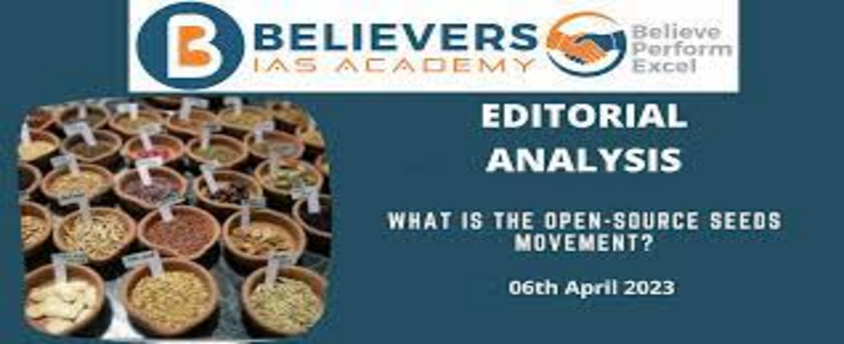Category: Plant breeders’ rights (PBR) and patents.
What is the open-source seeds movement?
07, Apr 2023

Why in News?
- Traditionally, farmers and cultivators have innovated and shared seeds without any intellectual property rights (IPR) for centuries.
- However, the advent of hybrid seeds and advancements in scientific plant-breeding have led to the grant of plant breeders’ rights (PBR) and patents.
- As per PBR and patents regime, rights-holders can demand royalty on seeds and legally enforce intellectual property rights (IPR) and in the case of a few regimes, rights-holders can also limit the unauthorised use of such seeds.
- Further, the establishment of the World Trade Organization (WTO) helped to put in place a global IPR regime for plant varieties.
- The Trade-Related IPR Agreement (TRIPS) also mandated countries to extend a minimum of one form of intellectual property (IP) protection.
- These developments led to the consolidation of rights in the seeds sector which led to various concerns about the freedom to innovate.
- The genetic revolution in agriculture, unlike the Green Revolution, was mainly led by the private sector, as hybrid seeds developed have been protected by strong IPRs.
Concerns associated with IPR protection in the agriculture sector
- There are mainly two modes of IPR protection in agriculture namely plant-breeders rights (PBR) and patents.
- These modes of IPR protection have restricted the rights of the farmers and the freedom to develop new varieties using germplasm from IP-protected varieties.
- Further, the high costs and prices associated with genetically modified seeds and IP claims have given rise to various problems and issues which have led to the State’s intervention in Bt cotton seeds in India.
- Also, the IPR regime in agriculture has led to the decline of public-sector breeding and the domination of private companies in the seed sector.
Open-source seeds model
- In 1999, a plant-breeder T.E. Michaels recommended the application of the principles used for the open-source software approach to seed innovation.
- In the coming years after the proposal in 1999, various scholars and civil-society members formulated policies on the open-source model for seeds and plant varieties.
- The German NGO Agrecol started an initiative in Europe and according to this model, the user agrees not to patent seeds bought under the open-source licence.
- Also in the U.S., a pledge-based model for sharing seeds was adopted as a part of the open-source seeds initiative.
- In India, the Hyderabad-based Centre for Sustainable Agriculture (CSA) came up with a model that included an agreement between the CSA and the recipient of the seed or germplasm.
- As per the provisions of India’s Plant Variety Protection and Farmers’ Rights Act 2001, farmers are allowed to register certain farmer varieties only if they meet certain conditions, and will be granted the right to reuse, replant, and exchange seeds.
- However, the farmers are mandated not to breed and trade such varieties protected under the Act for commercial purposes.
Significance of open-source seeds model
- The open-source approach leads to farmer-led seed conservation and distribution systems.
- The open-source approaches also play a significant role in ensuring food security and climate resilience in the country.
- There are various traditional-variety conservation and sharing methods adopted in India that are unique to specific regions and have specific features.
- However, such traditional varieties lack uniformity and cannot produce quality seeds.
- The open-source seed model can help address these issues by enabling testing, improvisation, and adoption.
- The open-source seed model also helps in promoting farmer-led participatory plant-breeding exercises.






